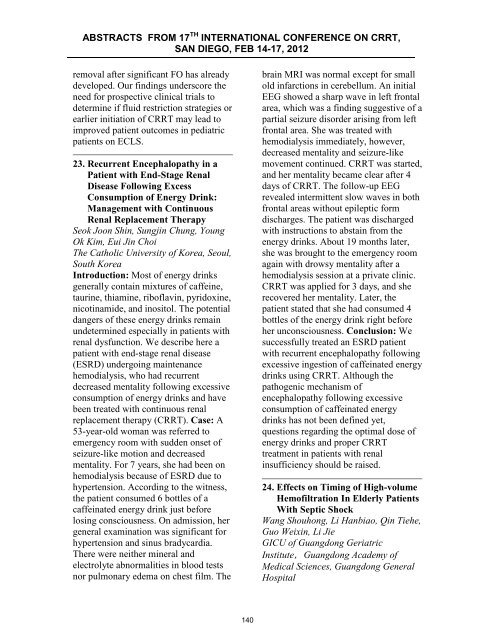ABSTRACTS from 16th International COnference on ... - CRRT Online
ABSTRACTS from 16th International COnference on ... - CRRT Online
ABSTRACTS from 16th International COnference on ... - CRRT Online
You also want an ePaper? Increase the reach of your titles
YUMPU automatically turns print PDFs into web optimized ePapers that Google loves.
<str<strong>on</strong>g>ABSTRACTS</str<strong>on</strong>g> FROM 17 TH INTERNATIONAL CONFERENCE ON <strong>CRRT</strong>,<br />
SAN DIEGO, FEB 14-17, 2012<br />
removal after significant FO has already<br />
developed. Our findings underscore the<br />
need for prospective clinical trials to<br />
determine if fluid restricti<strong>on</strong> strategies or<br />
earlier initiati<strong>on</strong> of <strong>CRRT</strong> may lead to<br />
improved patient outcomes in pediatric<br />
patients <strong>on</strong> ECLS.<br />
23. Recurrent Encephalopathy in a<br />
Patient with End-Stage Renal<br />
Disease Following Excess<br />
C<strong>on</strong>sumpti<strong>on</strong> of Energy Drink:<br />
Management with C<strong>on</strong>tinuous<br />
Renal Replacement Therapy<br />
Seok Jo<strong>on</strong> Shin, Sungjin Chung, Young<br />
Ok Kim, Eui Jin Choi<br />
The Catholic University of Korea, Seoul,<br />
South Korea<br />
Introducti<strong>on</strong>: Most of energy drinks<br />
generally c<strong>on</strong>tain mixtures of caffeine,<br />
taurine, thiamine, riboflavin, pyridoxine,<br />
nicotinamide, and inositol. The potential<br />
dangers of these energy drinks remain<br />
undetermined especially in patients with<br />
renal dysfuncti<strong>on</strong>. We describe here a<br />
patient with end-stage renal disease<br />
(ESRD) undergoing maintenance<br />
hemodialysis, who had recurrent<br />
decreased mentality following excessive<br />
c<strong>on</strong>sumpti<strong>on</strong> of energy drinks and have<br />
been treated with c<strong>on</strong>tinuous renal<br />
replacement therapy (<strong>CRRT</strong>). Case: A<br />
53-year-old woman was referred to<br />
emergency room with sudden <strong>on</strong>set of<br />
seizure-like moti<strong>on</strong> and decreased<br />
mentality. For 7 years, she had been <strong>on</strong><br />
hemodialysis because of ESRD due to<br />
hypertensi<strong>on</strong>. According to the witness,<br />
the patient c<strong>on</strong>sumed 6 bottles of a<br />
caffeinated energy drink just before<br />
losing c<strong>on</strong>sciousness. On admissi<strong>on</strong>, her<br />
general examinati<strong>on</strong> was significant for<br />
hypertensi<strong>on</strong> and sinus bradycardia.<br />
There were neither mineral and<br />
electrolyte abnormalities in blood tests<br />
nor pulm<strong>on</strong>ary edema <strong>on</strong> chest film. The<br />
brain MRI was normal except for small<br />
old infarcti<strong>on</strong>s in cerebellum. An initial<br />
EEG showed a sharp wave in left fr<strong>on</strong>tal<br />
area, which was a finding suggestive of a<br />
partial seizure disorder arising <str<strong>on</strong>g>from</str<strong>on</strong>g> left<br />
fr<strong>on</strong>tal area. She was treated with<br />
hemodialysis immediately, however,<br />
decreased mentality and seizure-like<br />
movement c<strong>on</strong>tinued. <strong>CRRT</strong> was started,<br />
and her mentality became clear after 4<br />
days of <strong>CRRT</strong>. The follow-up EEG<br />
revealed intermittent slow waves in both<br />
fr<strong>on</strong>tal areas without epileptic form<br />
discharges. The patient was discharged<br />
with instructi<strong>on</strong>s to abstain <str<strong>on</strong>g>from</str<strong>on</strong>g> the<br />
energy drinks. About 19 m<strong>on</strong>ths later,<br />
she was brought to the emergency room<br />
again with drowsy mentality after a<br />
hemodialysis sessi<strong>on</strong> at a private clinic.<br />
<strong>CRRT</strong> was applied for 3 days, and she<br />
recovered her mentality. Later, the<br />
patient stated that she had c<strong>on</strong>sumed 4<br />
bottles of the energy drink right before<br />
her unc<strong>on</strong>sciousness. C<strong>on</strong>clusi<strong>on</strong>: We<br />
successfully treated an ESRD patient<br />
with recurrent encephalopathy following<br />
excessive ingesti<strong>on</strong> of caffeinated energy<br />
drinks using <strong>CRRT</strong>. Although the<br />
pathogenic mechanism of<br />
encephalopathy following excessive<br />
c<strong>on</strong>sumpti<strong>on</strong> of caffeinated energy<br />
drinks has not been defined yet,<br />
questi<strong>on</strong>s regarding the optimal dose of<br />
energy drinks and proper <strong>CRRT</strong><br />
treatment in patients with renal<br />
insufficiency should be raised.<br />
24. Effects <strong>on</strong> Timing of High-volume<br />
Hemofiltrati<strong>on</strong> In Elderly Patients<br />
With Septic Shock<br />
Wang Shouh<strong>on</strong>g, Li Hanbiao, Qin Tiehe,<br />
Guo Weixin, Li Jie<br />
GICU of Guangd<strong>on</strong>g Geriatric<br />
Institute,Guangd<strong>on</strong>g Academy of<br />
Medical Sciences, Guangd<strong>on</strong>g General<br />
Hospital<br />
140
















